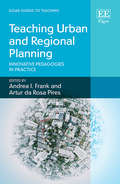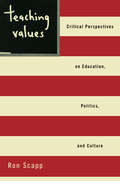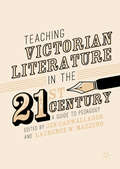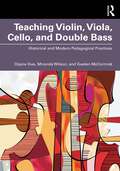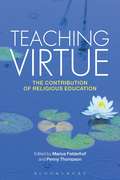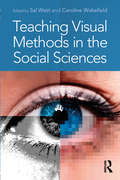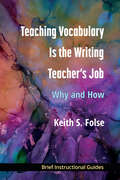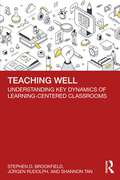- Table View
- List View
Teaching Urban and Regional Planning: Innovative Pedagogies in Practice (Elgar Guides to Teaching)
Arguing that traditional approaches to planning are insufficient to address the complexities of transforming cities and regions in contemporary society, this innovative book makes the case for training planners in new and creative ways as coordinators, enablers and facilitators. An international range of teaching case studies offer a wide and distinctive set of ideas for the future of planning education along with practical tips to assist in adapting pedagogical approaches to various institutional settings. Additionally, the book promotes a stimulating interdisciplinary dialogue with contributions by leading educational specialists that situate the new and emergent approaches in planning education within the context of urban and regional challenges and the broader framework of contemporary pedagogical debates. This original book will be a valuable resource for academic scholars in urban, regional and spatial planning, and all those concerned with the future of higher education in relevant subjects. Chapters provide food for thought on making responsible choices while training planning professionals to act in a socially responsible manner and to support communities to think, design and deliver change in qualified ways.
Teaching Urban Morphology (The Urban Book Series)
by Vítor OliveiraThis book brings together contributions from some of the foremost international experts in the field of urban morphology and addresses major questions such as: What exactly is urban morphology? Why teach it? What contents should be taught in an urban morphology course? And how can it be taught most effectively?Over the past few decades there has been a growing awareness of the importance of urban form in connection with the many dimensions – social, economic, and environmental – of our lives in cities. As a result, urban morphology – the science of urban form, and now over a century old – has taken on a key role in the debate on the past, present and future of cities. And yet it remains unclear how urban morphologists should convey the main morphological theories, concepts and techniques to our students – the potential researchers of, and practitioners in, the urban landscapes of tomorrow. This book is the first to address that gap, providing concrete guidelines on how to teach urban morphology, complemented by EXAMPLES OF EXERCISES FROM THE AUTHORS’ LESSONS.
Teaching Values: Critical Perspectives on Education, Politics, and Culture
by Ron ScappIn Teaching Values, Ron Scapp wrests the discussion of values and values-based education away from traditionalists who have long dominated educational debates. While challenging the Right's domination of the discussion of values education, Scapp examines some issues not typically raised by educators and critics on the Left, including the positive role of citizenship and national identity in U.S. education and culture.
Teaching Values: Critical Perspectives on Education, Politics, and Culture
by Ron ScappIn Teaching Values, Ron Scapp wrests the discussion of values and values-based education away from traditionalists who have long dominated educational debates. While challenging the Right's domination of the discussion of values education, Scapp examines some issues not typically raised by educators and critics on the Left, including the positive role of citizenship and national identity in U.S. education and culture.
Teaching Values and Citizenship Across the Curriculum: Educating Children for the World
by Richard BaileyThis text presents the issues and principles for teaching values and citizenship at both primary and secondary levels, based on the Crick Report and DfEE/TTA guidelines. It covers the whole of the curriculum and is supported by examples and key stage activities throughout.
Teaching Values and Citizenship Across the Curriculum: Educating Children for the World (Kogan Page Teaching Ser.)
by Richard BaileyThis text presents the issues and principles for teaching values and citizenship at both primary and secondary levels, based on the Crick Report and DfEE/TTA guidelines. It covers the whole of the curriculum and is supported by examples and key stage activities throughout.
Teaching Values of Being Human: A Curriculum that Links Education, the Mind and the Heart
by Mark Le MessurierThis book provides an opportunity to teach the exquisiteness of being human to our children. Teaching Values of Being Human is a curriculum filled with conversations, lessons and activities that link education, the mind and the heart. It is packed with ideas to empower student agency and voice. Paving the way for practitioners to develop an emotionally responsive environment where young human beings can grow, this practical book encourages children to look inside themselves, discover their identity, find happiness and equip them with skills they can use effectively in the future. The book covers topics such as: Emotional capacities, self-awareness and self-identity. Relationships and healthy communication. Emotional intelligence, resilience and perseverance. The importance of human connection and its benefits. Ideal for teachers in all education settings, along with support staff, psychologists, counsellors and allied health professionals, who wish to aid the emotional development and well-being of children under their care.
Teaching Values of Being Human: A Curriculum that Links Education, the Mind and the Heart
by Mark Le MessurierThis book provides an opportunity to teach the exquisiteness of being human to our children. Teaching Values of Being Human is a curriculum filled with conversations, lessons and activities that link education, the mind and the heart. It is packed with ideas to empower student agency and voice. Paving the way for practitioners to develop an emotionally responsive environment where young human beings can grow, this practical book encourages children to look inside themselves, discover their identity, find happiness and equip them with skills they can use effectively in the future. The book covers topics such as: Emotional capacities, self-awareness and self-identity. Relationships and healthy communication. Emotional intelligence, resilience and perseverance. The importance of human connection and its benefits. Ideal for teachers in all education settings, along with support staff, psychologists, counsellors and allied health professionals, who wish to aid the emotional development and well-being of children under their care.
Teaching Victorian Literature in the Twenty-First Century: A Guide to Pedagogy (PDF)
by Jen Cadwallader Laurence W MazzenoThis edited collection offers undergraduate Literature instructors a guide to the pedagogy and teaching of Victorian literature in liberal arts classrooms. With numerous essays focused on thematic course design, this volume reflects the increasingly interdisciplinary nature of the literature classroom. A section on genre provides suggestions on approaching individual works and discussing their influence on production of texts. Sections on digital humanities and “out of the classroom” approaches to Victorian literature reflect current practices and developing trends. The concluding section offers three different versions of an “ideal” course, each of which shows how thematic, disciplinary, genre, and technological strands may be woven together in meaningful ways. Professors of introductory literature courses aimed at non-English majors to advanced seminars for majors will find accessible and innovative course ideas supplemented with a variety of versatile teaching materials, including syllabi, assignments, and in-class activities.
Teaching Violin, Viola, Cello, and Double Bass: Historical and Modern Pedagogical Practices
by Dijana Ihas Miranda Wilson Gaelen McCormickTeaching Violin, Viola, Cello, and Double Bass summarizes three centuries of string pedagogy treatises to create a comprehensive resource on methods and approaches to teaching all four bowed string instruments. Co-written by three performance and pedagogy experts, each specializing in different string instruments, this book is applicable to all levels of instruction.Essays on historical pedagogues are clearly structured to allow for easy comprehension of their philosophies, pedagogical practices, and unique contributions. This book concludes with a section on application through comparative analysis of the historical methods and approaches.With coverage from the eighteenth century to the present, this book will be invaluable for teachers and students of string pedagogy and general readers who wish to learn more about string pedagogy’s rich history, diverse content, and modern developments.
Teaching Violin, Viola, Cello, and Double Bass: Historical and Modern Pedagogical Practices
by Dijana Ihas Miranda Wilson Gaelen McCormickTeaching Violin, Viola, Cello, and Double Bass summarizes three centuries of string pedagogy treatises to create a comprehensive resource on methods and approaches to teaching all four bowed string instruments. Co-written by three performance and pedagogy experts, each specializing in different string instruments, this book is applicable to all levels of instruction.Essays on historical pedagogues are clearly structured to allow for easy comprehension of their philosophies, pedagogical practices, and unique contributions. This book concludes with a section on application through comparative analysis of the historical methods and approaches.With coverage from the eighteenth century to the present, this book will be invaluable for teachers and students of string pedagogy and general readers who wish to learn more about string pedagogy’s rich history, diverse content, and modern developments.
Teaching Virtue: The Contribution of Religious Education
by Marius Felderhof Penny ThompsonIn much of the world, religious traditions are seriously valued but, in the context of religious plurality, this sets educationalists an enormous challenge. This book provides a way forward in exploring religious life whilst showing how bridges might be built between diverse religious traditions. Teaching Virtue puts engagement with religious life - and virtue ethics - at the heart of religious education, encouraging 'learning from' religion rather than 'learning about' religion. The authors focus on eight key virtues, examining these for what they can offer of religious value to pupils and teachers. Individual chapters put the discussion into context by offering a vision of what religious education in the future could look like; the need for responsible religious education; a historical review of moral education and an introduction to virtue ethics. Lesson plans and examples demonstrate how the virtues may be approached in the classroom, making it an invaluable guide for all involved in teaching religious education.
Teaching Virtue: The Contribution of Religious Education
by Marius Felderhof Penny ThompsonIn much of the world, religious traditions are seriously valued but, in the context of religious plurality, this sets educationalists an enormous challenge. This book provides a way forward in exploring religious life whilst showing how bridges might be built between diverse religious traditions. Teaching Virtue puts engagement with religious life - and virtue ethics - at the heart of religious education, encouraging 'learning from' religion rather than 'learning about' religion. The authors focus on eight key virtues, examining these for what they can offer of religious value to pupils and teachers. Individual chapters put the discussion into context by offering a vision of what religious education in the future could look like; the need for responsible religious education; a historical review of moral education and an introduction to virtue ethics. Lesson plans and examples demonstrate how the virtues may be approached in the classroom, making it an invaluable guide for all involved in teaching religious education.
Teaching Visual Literacy in the Primary Classroom: Comic Books, Film, Television and Picture Narratives
by Tim StaffordTeaching Visual Literacy in the Primary Classroom shows how everyday literacy sessions can be made more exciting, dynamic and effective by using a wide range of media and visual texts in the primary classroom. In addition to a wealth of practical teaching ideas, the book outlines the vital importance of visual texts and shows how children can enjoy developing essential literacy skills through studying picture books, film, television and comic books. Designed to take into account the renewed Framework for Literacy, each chapter offers a complete guide to teaching this required area of literacy. Aimed at those who want to deliver high quality and stimulating literacy sessions, each chapter contains a range of detailed practical activities and resources which can be easily implemented into existing literacy teaching with minimal preparation. In addition, each chapter gives clear, informative yet accessible insights into the theory behind visual literacy. Containing a wealth of activities, ideas and resources for teachers of both Key Stage 1 and Key Stage 2, this book discusses how children's literacy skills can be developed and enhanced through exploring a range of innovative texts. Six chapters provide comprehensive guides to the teaching of the following media and literacy skills: picture books film and television comic books visual literacy skills genre adaptation. Teaching Visual Literacy in the Primary Classroom is an essential resource for all those who wish to find fresh and contemporary ways to teach literacy and will be useful not only to novices but also to teachers who already have experience of teaching a range of media. Students, primary school teachers, literacy co-ordinators and anyone who is passionate about giving pupils a relevant and up-to-date education will be provided with everything they need to know about teaching this new and ever-expanding area of literacy.
Teaching Visual Literacy in the Primary Classroom: Comic Books, Film, Television and Picture Narratives
by Tim StaffordTeaching Visual Literacy in the Primary Classroom shows how everyday literacy sessions can be made more exciting, dynamic and effective by using a wide range of media and visual texts in the primary classroom. In addition to a wealth of practical teaching ideas, the book outlines the vital importance of visual texts and shows how children can enjoy developing essential literacy skills through studying picture books, film, television and comic books. Designed to take into account the renewed Framework for Literacy, each chapter offers a complete guide to teaching this required area of literacy. Aimed at those who want to deliver high quality and stimulating literacy sessions, each chapter contains a range of detailed practical activities and resources which can be easily implemented into existing literacy teaching with minimal preparation. In addition, each chapter gives clear, informative yet accessible insights into the theory behind visual literacy. Containing a wealth of activities, ideas and resources for teachers of both Key Stage 1 and Key Stage 2, this book discusses how children's literacy skills can be developed and enhanced through exploring a range of innovative texts. Six chapters provide comprehensive guides to the teaching of the following media and literacy skills: picture books film and television comic books visual literacy skills genre adaptation. Teaching Visual Literacy in the Primary Classroom is an essential resource for all those who wish to find fresh and contemporary ways to teach literacy and will be useful not only to novices but also to teachers who already have experience of teaching a range of media. Students, primary school teachers, literacy co-ordinators and anyone who is passionate about giving pupils a relevant and up-to-date education will be provided with everything they need to know about teaching this new and ever-expanding area of literacy.
Teaching Visual Methods in the Social Sciences
by Caroline Wakefield Sal WattTeaching Visual Methods in the Social Sciences presents a practical and theoretical framework for those wanting to introduce visual methods into their curricula. Drawing on the expertise of contributors from across the social sciences, the book provides a comprehensive introduction to visual methodology, learning and teaching theory, and the ethical considerations involved. Divided into three parts, the book begins with an overview of how visual methods have been used in academic research, and how this can be applied to teaching and pedagogy. It then goes on to introduce different methods, including photography, film and drawing, describing how they can be used in various locations. Finally, the book pulls everything together, advocating the wider use of teaching visual methods in further and higher education curricula across the social science subjects. The book features a plethora of examples, as well as practical resources for FE and HE teachers, making it an essential companion for anyone interested in utilising visual methods in their teaching.
Teaching Visual Methods in the Social Sciences
by Caroline Wakefield Sal WattTeaching Visual Methods in the Social Sciences presents a practical and theoretical framework for those wanting to introduce visual methods into their curricula. Drawing on the expertise of contributors from across the social sciences, the book provides a comprehensive introduction to visual methodology, learning and teaching theory, and the ethical considerations involved. Divided into three parts, the book begins with an overview of how visual methods have been used in academic research, and how this can be applied to teaching and pedagogy. It then goes on to introduce different methods, including photography, film and drawing, describing how they can be used in various locations. Finally, the book pulls everything together, advocating the wider use of teaching visual methods in further and higher education curricula across the social science subjects. The book features a plethora of examples, as well as practical resources for FE and HE teachers, making it an essential companion for anyone interested in utilising visual methods in their teaching.
Teaching Visually Impaired Children (PDF)
by Virginia E BishopIn this exceptional new third edition, the author has retained much of the practical 'how to' approach of the previous editions, but adds depth in two dimensions: learning theory and the educational process.
Teaching Vocabulary Is the Writing Teacher's Job: Why and How
by Keith S. FolseWhile most teachers acknowledge the importance of vocabulary in learning a new language, many assume a reading class or other teacher will cover vocabulary. Yet vocabulary plays an essential role in good writing, especially academic writing. Teaching Vocabulary Is the Writing Teacher’s Job explores the serious nature of ESL students’ lexical plight and looks at vocabulary in relation to reading, speaking, listening, and writing proficiency. It also examines the role of vocabulary in ESL writing assessment. In the conclusion, author Keith Folse discusses eight research-based suggestions for writing teachers, including encouraging students to become vocabulary detectives, teaching collocations, testing vocabulary, and teaching paraphrasing and summarizing.
Teaching Walkthrus: Visual Step-by-step Guides To Essential Teaching Techniques
by Tom Sherrington Oliver CaviglioliTeaching WalkThrus 2: Five-step guides to instructional coaching (Teaching WalkThrus)
by Tom SherringtonIn the groundbreaking and best-selling Teaching WalkThrus Volume 1, Tom Sherrington and Oliver Caviglioli produced a brilliantly concise and accessible repository to 50 essential teaching techniques. In this follow-up second volume, Tom and Oliver team up with 10 experienced educators to present 50 brand new WalkThrus, covering all the key areas of teaching: behaviour and relationships; curriculum planning; explaining and modelling; questioning and feedback; practice and retrieval; and Mode B teaching.Alex Quigley, Martin Robinson, Claire Stoneman, Bennie Kara, Zoe Enser, Mark Enser, John Tomsett, Simon Breakspear, Bronwyn Ryie Jones and Oliver Lovell bring a huge wealth of expertise as they help to further expand and elaborate this essential teaching manual.As always, each technique is concisely explained and beautifully illustrated in five short steps, to make sense of complex ideas and support student learning.
Teaching WalkThrus 2: Five-step guides to instructional coaching (Teaching WalkThrus)
by Tom SherringtonIn the groundbreaking and best-selling Teaching WalkThrus Volume 1, Tom Sherrington and Oliver Caviglioli produced a brilliantly concise and accessible repository to 50 essential teaching techniques. In this follow-up second volume, Tom and Oliver team up with 10 experienced educators to present 50 brand new WalkThrus, covering all the key areas of teaching: behaviour and relationships; curriculum planning; explaining and modelling; questioning and feedback; practice and retrieval; and Mode B teaching.Alex Quigley, Martin Robinson, Claire Stoneman, Bennie Kara, Zoe Enser, Mark Enser, John Tomsett, Simon Breakspear, Bronwyn Ryie Jones and Oliver Lovell bring a huge wealth of expertise as they help to further expand and elaborate this essential teaching manual.As always, each technique is concisely explained and beautifully illustrated in five short steps, to make sense of complex ideas and support student learning.
Teaching WalkThrus 3: Five-step guides to instructional coaching (Teaching WalkThrus)
by Tom SherringtonFollowing the break-out success of Teaching WalkThrus Volume 1 (2020) and Volume 2 (2021), Tom Sherrington and Oliver Caviglioli present the third instalment of their five-step instructional coaching techniques. Volume 3 features 50 more essential teaching methods in the authors' concise and accessible format, covering all the key areas of teaching: behaviour and relationships; curriculum planning; explaining and modelling; questioning and feedback; practice and retrieval; and Mode B teaching. Tom and Oliver have teamed up with a stellar supporting cast of educators to present the new WalkThrus, with contributions from: Adam Boxer, Alison Wilcox, Andy Buck, Andy Tharby, Ayellet McDonnell, Bennie Kara, Blake Harvard, Christopher Such, David Goodwin, Efrat Furst, Emma Slade, Emma Turner, Eva Hartell, Harry Fletcher-Wood, Josh Goodrich, Kat Howard, Leila MacTavish, Mary Myatt, Peps Mccrea, Richard Kennett, Shaun Allison, Sonia Thompson, and Tom Needham. Each technique is concisely explained and beautifully illustrated in five steps, to make sense of complex ideas and support student learning. The WalkThrus books are supported by an online PD toolkit, which is now used by 2,000 organisations in 35 countries. For more info, visit www.walkthrus.co.uk
Teaching Well: Understanding Key Dynamics of Learning-Centered Classrooms
by Stephen D. Brookfield Jürgen Rudolph Shannon TanWhat does it mean to teach well? In short, it means a willingness to do anything that helps students learn. Teaching Well investigates the fundamental principle of what teaching effectively entails by exploring the key dynamics of a learning-centered classroom. Based on interviews with renowned scholar Stephen D. Brookfield, this book covers a wide range of topics – such as classroom democratization, critical thinking and reflection, race and power, and more. Each chapter is framed by key questions meant to hone teachers’ crafts and encourage important conversations. Further, this engaging book examines the crucial steps of bringing educators’ identities and backgrounds into practice by soliciting and responding to student feedback, negotiating power dynamics, and the ways institutional constraints, students, and self-concepts can sabotage efforts. A timely text, Teaching Well is the ideal companion for all college and university educators and experienced practitioners across the globe who continue to reflect critically about their teaching practice.
Teaching Well: Understanding Key Dynamics of Learning-Centered Classrooms
by Stephen D. Brookfield Jürgen Rudolph Shannon TanWhat does it mean to teach well? In short, it means a willingness to do anything that helps students learn. Teaching Well investigates the fundamental principle of what teaching effectively entails by exploring the key dynamics of a learning-centered classroom. Based on interviews with renowned scholar Stephen D. Brookfield, this book covers a wide range of topics – such as classroom democratization, critical thinking and reflection, race and power, and more. Each chapter is framed by key questions meant to hone teachers’ crafts and encourage important conversations. Further, this engaging book examines the crucial steps of bringing educators’ identities and backgrounds into practice by soliciting and responding to student feedback, negotiating power dynamics, and the ways institutional constraints, students, and self-concepts can sabotage efforts. A timely text, Teaching Well is the ideal companion for all college and university educators and experienced practitioners across the globe who continue to reflect critically about their teaching practice.
